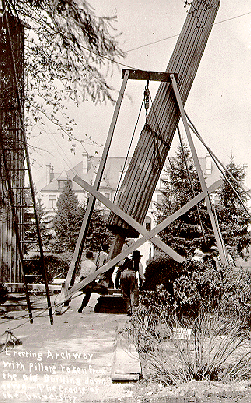“We think the expense already too great for the public good of the Territory. In fact, if the matter is well considered, we shall find that we are not yet prepared for a Territorial University. We have reason to believe that there is not a young man in the Territory who could pass an examination to enter the University course. Hence, where is the propriety of spending all this money? There is not in all King County one hundred children of lawful age to attend even a district school. Our common schools demand our attention first; then our high schools, academies, colleges and universities, but in the above matters are reversed-University first, then come common schools. We feel it to be our duty to enter officially our protest against this hasty expenditure of our public school funds. We hold that public good should never be sacrificed for individual interest.”
— Territorial School Superintendent B. C. Lippincott, December 10, 1861
(in Prosch, Thomas W. A Chronological History of Seattle, from 1850 to 1897 Prepared in 1900 and 1901 .)

Seattle 1866; photograph by Frederick Dally, courtesy of the Metropolitan Toronto Library Board.
(The University building is on the hill in the center of the photograph.)
On November 4, 1861, the Territorial University of Washington began classes in a building located on a site now occupied by the Olympic Hotel. The University was on the outskirts of the village of Seattle, which had a population of 250. (The 1860 census identified 302 people in King County.)

The Territorial University Building (UW 2403)
The University’s existence was due to the leadership of the Reverend Daniel Bagley, a Methodist preacher, and the donation of eight acres of land by Arthur and Mary Denny. An additional two acres were deeded by Charles and Mary Terry and Edward Lander. A. S. Mercer was the first “Professor and Teacher”. He later achieved fame as the man who arranged the emigration of a number of unmarried women, “the Mercer girls,”, from Boston to Washington Territory, where there was a shortage of unmarried women.
In the early years, most of the students were Seattle school children, with very few students at the collegiate level. It was fifteen years before the University granted its first collegiate degree. In June 1876, Clara A. McCarty received a Bachelor of Science diploma. Between 1861 and 1898, only 71 bachelor’s degrees and 27 teacher’s diplomas and certificates were conferred.

Students and a few of the faculty of the Territorial University of Washington, 1883 (UW 2227)

“On the old University steps about 1888 or 89” (UW 422)
For many years the Territorial University was plagued with financial and administrative problems. It closed in 1863, from 1867-69, and again in 1874 and in 1876 (the last “on account of poverty”). From 1882-84 the Legislature failed to grant the University funds. Henry Villard, President of the Northern Pacific Railroad, contributed $4,000 during this period and saved the University from closing yet again. From 1861 to 1895 there were ten presidents with Thomas Gatch serving the longest from 1887-1895.
“It can hardly be said that we have a University except in name.”
— Governor Elisha P. Ferry, 1873
Courses of Study, 1875
The 1875 Register of the Territorial University of Washington Territory, the first published University catalog, lists the “Courses of Study”. Tuition was $12.00 per term for the Collegiate or Scientific Department.
“The Course of Instruction laid down, it will be seen, is in accordance with the aim and design of the University; to bring it as speedily as possible to a condition which will enable the youth of the Territory, of both sexes, to obtain a thorough education, which shall prepare them for the duties of an active life. Preparatory steps have been taken, and in the coming year will be carried on, to secure the early formation of classes to pursue a regular course of study.”
— Register of the Territorial University. Seattle, Washington Territory, 1875

Territorial University of Washington Faculty, 1882-3. (Peiser 184)
The Columns
The cedar columns that supported the porch of the old Territorial University Building were removed when the building was moved to make room for new buildings on the original site. They were stored until 1911, when they were erected on Campus Day, April 28, on the path leading to Denny Hall. The columns were named Loyalty, Industry, Faith, and Efficiency (LIFE). On February 18, 1921, they were moved to their present site in the Sylvan Theatre. By 1958 the capitals on the columns had decayed and were replaced with fiberglass duplicates. The columns are all that remains of the University’s first building.

“Erecting archway with pillars taken from the old University Building downtown” 1911 (UW 2214)

The Columns in the Sylvan Theatre (UW 6272)